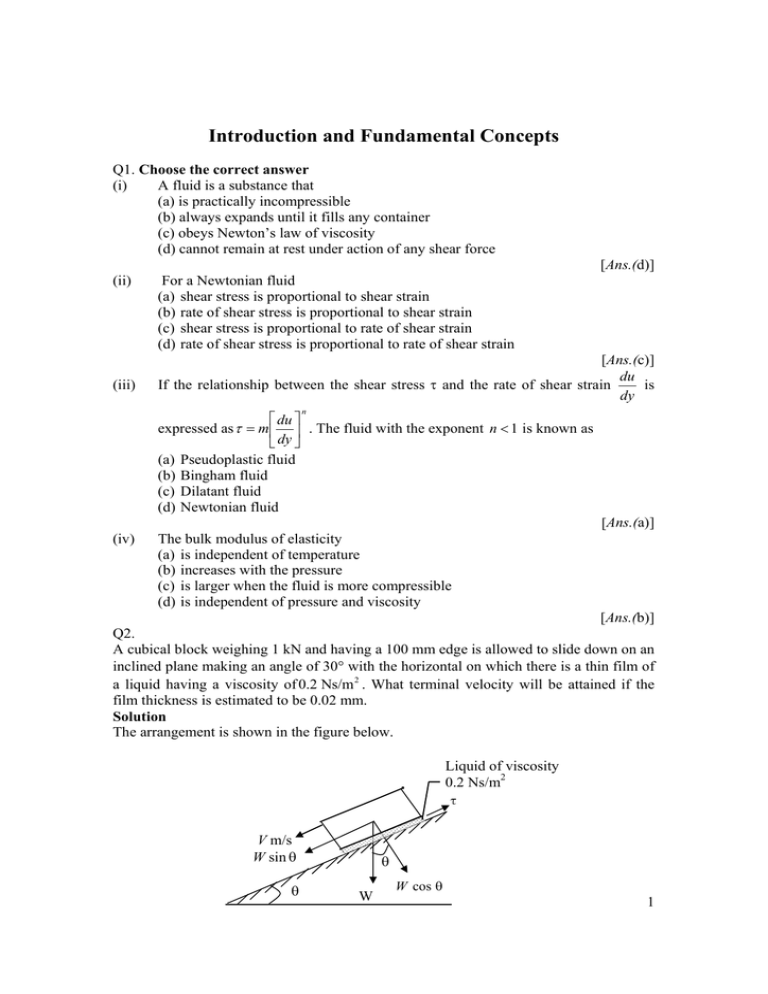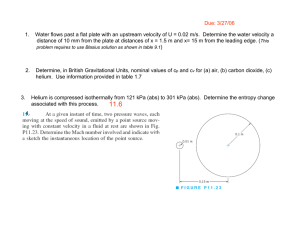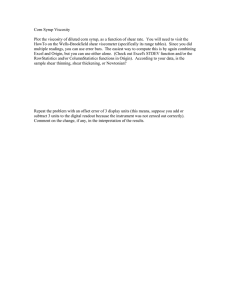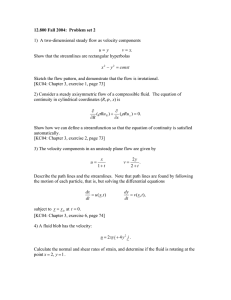Self Evaluation
advertisement

Introduction and Fundamental Concepts Q1. Choose the correct answer (i) A fluid is a substance that (a) is practically incompressible (b) always expands until it fills any container (c) obeys Newton’s law of viscosity (d) cannot remain at rest under action of any shear force [Ans.(d)] (ii) (iii) For a Newtonian fluid (a) shear stress is proportional to shear strain (b) rate of shear stress is proportional to shear strain (c) shear stress is proportional to rate of shear strain (d) rate of shear stress is proportional to rate of shear strain [Ans.(c)] du is If the relationship between the shear stress and the rate of shear strain dy n du expressed as m . The fluid with the exponent n 1 is known as dy (a) Pseudoplastic fluid (b) Bingham fluid (c) Dilatant fluid (d) Newtonian fluid [Ans.(a)] (iv) The bulk modulus of elasticity (a) is independent of temperature (b) increases with the pressure (c) is larger when the fluid is more compressible (d) is independent of pressure and viscosity [Ans.(b)] Q2. A cubical block weighing 1 kN and having a 100 mm edge is allowed to slide down on an inclined plane making an angle of 30 with the horizontal on which there is a thin film of a liquid having a viscosity of 0.2 Ns/m 2 . What terminal velocity will be attained if the film thickness is estimated to be 0.02 mm. Solution The arrangement is shown in the figure below. Liquid of viscosity 0.2 Ns/m2 V m/s W sin W W cos 1 For a thin film, velocity distribution can be assumed to be linear. Hence, the velocity gradient is found to be du V dy h where h is the thickness of the oil film. Viscous resistance F is given by F A where is the shear stress which can be expressed in terms of velocity gradient using Newton’s law of viscosity as du dy and A is the area of the block. Thus the viscous resistance becomes V F A h At the terminal condition, equilibrium occurs. Hence, the viscous resistance to the motion should be equal to the component of the weight of the solid block along the slope. Thus, V A W sin h Substituting the respective values, one can write V 0.2 0.01 1000sin 30 0.02 103 or V 5 m/s Q3. A thin 30 cm×30 cm flat plate is pulled at the rate of 1.5 m/s horizontally through a 4 mm thick oil layer sandwiched between two plates, one stationary and the other moving at a constant velocity of 0.3 m/s as shown in the figure below. Viscosity of the oil is 0.025 Pa.s. Assuming velocity in each oil layer to vary linearly, (a) Find the location where the oil velocity is zero. (b) Determine the force that needs to be applied to the plate moving at 1.5 m/s to maintain its motion. y Stationary plate 1 mm U = 1.5 m/s F Oil 3 mm U = 0.3 m/s x 2 Solution (a) From the statement of the problem, it is clear that the velocity is zero in between the moving plates. For 0 y 3 mm , let the velocity profile is u Ay B where A, and B are constants and their values are to be determined from the boundary conditions as given below (i) u 0.3 m/s at y 0 (ii) u 1.5 m/s at y 3 mm From first boundary condition (i), we find 0.3 A 0 B or B 0.3 From second boundary condition (ii), we get 1.5 A 0.003 B or 1.5 0.003 A 0.3 or A 600 The velocity profile is u 600 y 0.3 For zero velocity, we have 0 600 y 0.3 0.3 or y 0.0005 m 0.5 mm 600 (b)Let F1 and F2 be the shear forces on the lower surface and upper surface of the plate moving at 1.5 m/s respectively. From Newton’s law of viscosity, shear stress on the lower surface of the plate, 1 is given by du 1 dy 0.025 600 15N/m 2 Shear force on the lower surface of the plate is F1 1 A 15 0.09 1.35N For 3 mm y 4 mm , the velocity gradient is found to be du 1.5 1500 per s (in consideration of a linear velocity dy 0.001 profile) Shear stress on the upper surface of the plate, 2 is given by du 2 dy 0.025 1500 37.5N/m 2 Shear force on the upper surface of the plate is F2 2 A 37.5 0.09 3.375 N 3 Force exerted by the liquid on the plate is the sum of the forces on either surface of the plate. Therefore, total force applied to maintain the velocity is F F1 F2 1.35 3.375 4.725 N Q4. A circular disc of radius R is kept at a small height h above a fixed bed by means of a layer of oil of dynamic viscosity, as shown in the figure below. If the disc is rotated at an angular velocity,, obtain an expression for the viscous torque on the disc. Assume linear variation of velocity within the oil film. R h Oil r dr Solution Consider an element of disc at a radial distance r with width dr as shown in the figure below. For linear variation of velocity with depth, the velocity gradient is given by du u r dy h h Elemental shear stress is then du r h dy Elemental shear force is given by r dF dA 2rdr h Viscous torque acting on the element is r 2rdrr 2r 3dr dT dFr h h Total viscous torque on the disc is then R 2 R 4 R 4 T dT 2r 3 dr 4 h h h 2 0 Q5. Air is flowing through a tube such that the air pressures at two sections are 8 kPa (gauge) and 5 kPa (gauge) respectively, at the same temperature. It is given that flow can be 4 considered as incompressible if the density of the fluid changes by less than 5%. Do you think that this flow could be considered an incompressible flow? Assume atmospheric pressure equals to 101 kPa. Solution Pressure at section 1, p1 8 kPa (gauge) 8 kPa+101 kPa 109 kPa (Absolute) (Using the relation pabs patm pgauge ) Pressure at section 2, p2 5 kPa (gauge) 5 kPa+101 kPa 106 kPa (Absolute) For constant temperature, we have p1 p2 1 2 2 p2 or, 1 p1 The percent change in air densities between two sections is 1 2 100 1 1 2 100 1 p 1 2 100 p1 106 1 100 2.75% 109 Since 2.75% 5% , the flow could be considered incompressible. Q5. a Two concentric glass tubes of radii ro and ri respectively are immersed vertically in bath of water. Derive an expression for capillary rise. Take the surface tension of water in contact with air as , the area wetting contact angle as and the density of water as . Solution The arrangement is shown in the figure below. 5 Equating the weight of water column in the annulus with the total surface tension force, we have g ro2 ri 2 h 2ro 2ri cos or h 2 cos g ro ri 6



